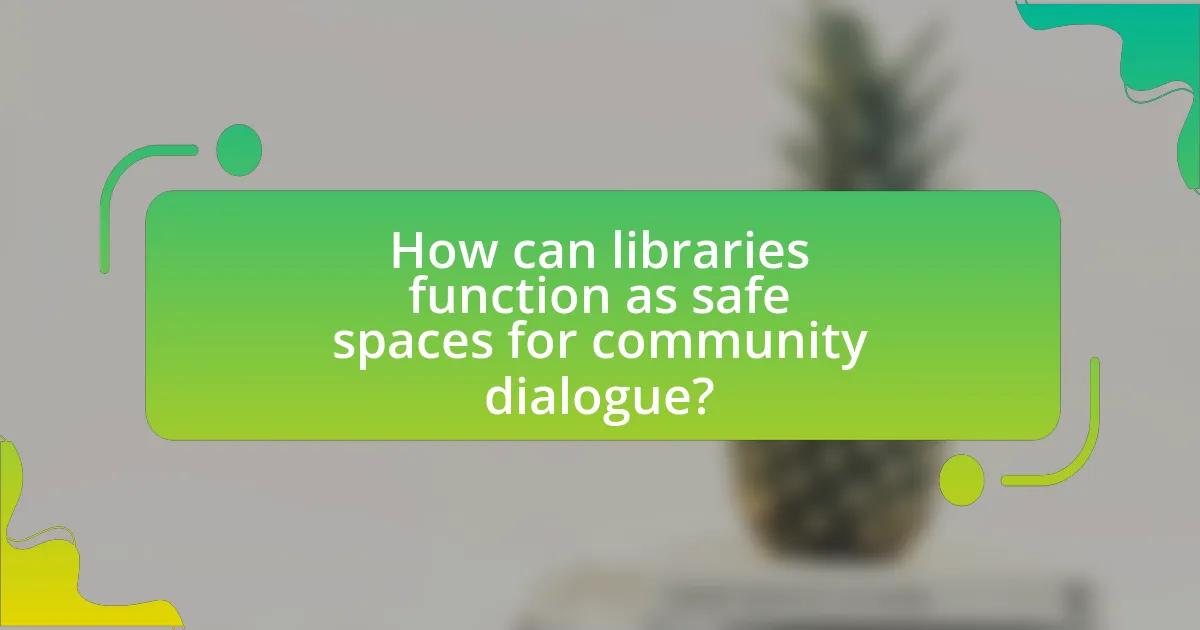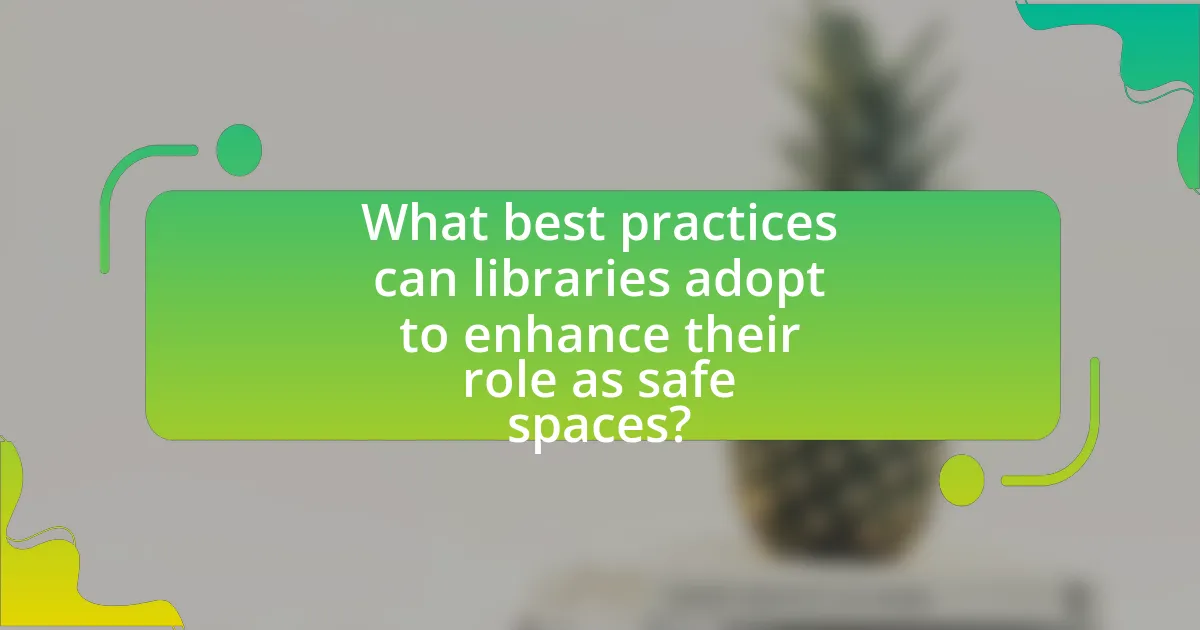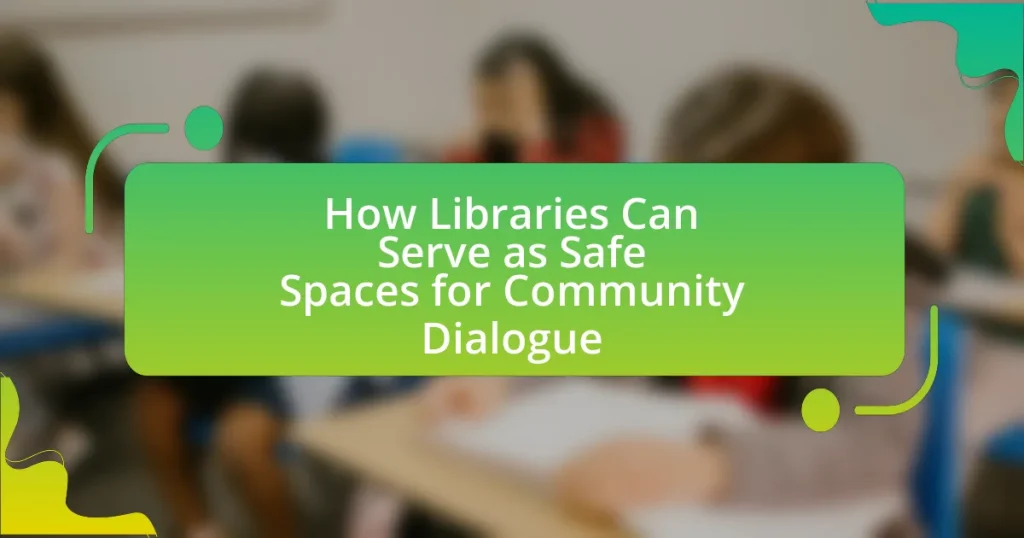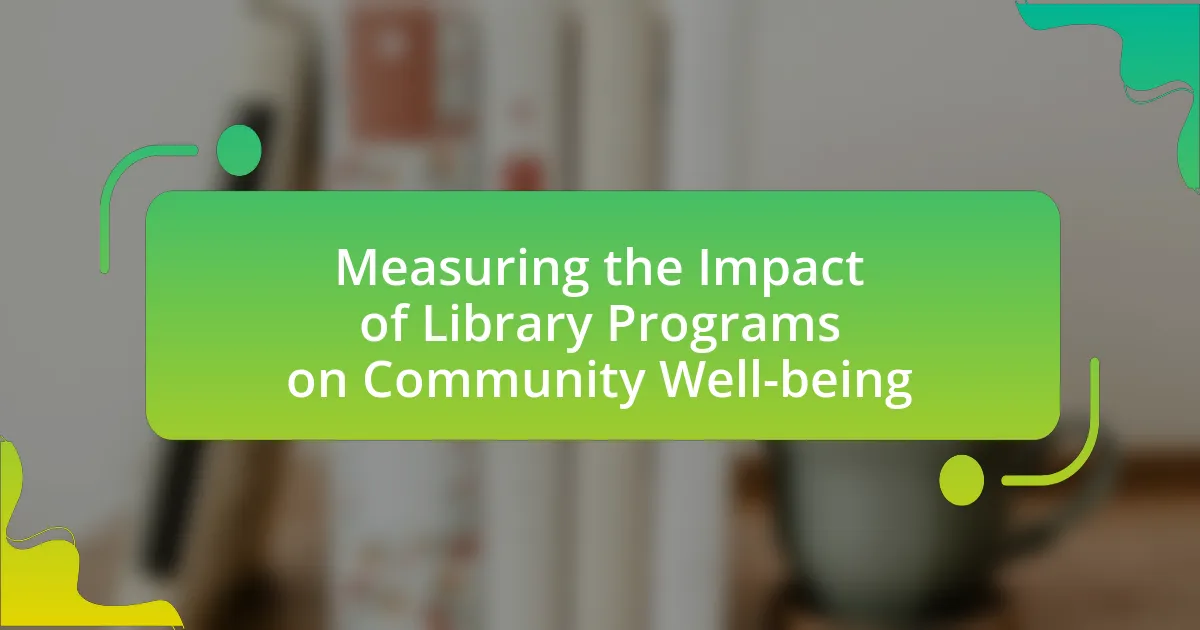Libraries serve as vital safe spaces for community dialogue by providing neutral environments where diverse groups can engage in discussions without fear of judgment. Key characteristics of these safe spaces include inclusivity, respect, and accessibility, which are essential for fostering open communication. The physical design of libraries, along with trained staff, enhances safety and encourages participation in community dialogue programs. Libraries implement various initiatives, such as workshops and discussion panels, to promote engagement and address local issues, ultimately strengthening community bonds and fostering understanding among residents.

How can libraries function as safe spaces for community dialogue?
Libraries can function as safe spaces for community dialogue by providing neutral environments where diverse groups can gather, share ideas, and engage in discussions without fear of judgment. These institutions often host programs and events that encourage open dialogue on various topics, including social issues, cultural differences, and community needs. For instance, the American Library Association emphasizes that libraries promote inclusivity and access to information, which fosters understanding and collaboration among community members. Additionally, libraries often implement policies that support free expression and protect the rights of individuals to voice their opinions, further solidifying their role as safe spaces for dialogue.
What characteristics define a safe space in libraries?
A safe space in libraries is characterized by inclusivity, respect, and accessibility. Inclusivity ensures that all individuals, regardless of background, identity, or beliefs, feel welcomed and valued within the library environment. Respect is fostered through policies and practices that promote open dialogue and discourage discrimination or harassment. Accessibility involves providing physical and digital resources that cater to diverse needs, ensuring that everyone can engage with library services. These characteristics are essential for creating an environment where community dialogue can thrive, as they encourage participation and foster a sense of belonging among patrons.
How do physical environments contribute to safety in libraries?
Physical environments contribute to safety in libraries by incorporating design elements that enhance security and accessibility. Features such as clear sightlines, adequate lighting, and open spaces reduce the risk of accidents and deter criminal activity. For instance, well-lit areas allow for better visibility, which can discourage potential threats, while open layouts facilitate supervision by staff and patrons alike. Additionally, the presence of emergency exits and safety signage ensures that individuals can quickly evacuate in case of an emergency, further promoting a secure atmosphere. Research indicates that libraries designed with safety in mind not only protect users but also foster a sense of community, encouraging more individuals to utilize these spaces.
What role does library staff play in creating a safe space?
Library staff play a crucial role in creating a safe space by fostering an inclusive environment that welcomes diverse perspectives. They achieve this by implementing policies that promote respect and understanding among patrons, ensuring that all individuals feel valued and heard. For instance, library staff are trained to handle conflicts sensitively and to provide resources that support marginalized communities, thereby reinforcing the library’s commitment to equity and access. Research indicates that libraries that prioritize staff training in diversity and inclusion see increased patron engagement and satisfaction, highlighting the effectiveness of staff initiatives in cultivating a safe atmosphere.
Why is community dialogue important in libraries?
Community dialogue is important in libraries because it fosters inclusivity and engagement among diverse populations. Libraries serve as neutral spaces where individuals can share perspectives, discuss issues, and collaborate on solutions, thereby strengthening community bonds. Research indicates that libraries that facilitate community dialogue programs see increased participation and a sense of belonging among patrons, which enhances social cohesion and civic engagement. For example, a study by the American Library Association found that libraries hosting community discussions reported higher levels of community involvement and improved relationships among residents.
How does community dialogue foster inclusivity and understanding?
Community dialogue fosters inclusivity and understanding by creating a platform for diverse voices to share their perspectives and experiences. This interaction encourages empathy and reduces biases, as participants engage in active listening and open communication. Research indicates that structured dialogues in community settings, such as libraries, can lead to increased social cohesion and a greater sense of belonging among participants. For instance, a study by the National Coalition for Dialogue & Deliberation found that community dialogues can enhance mutual respect and understanding, ultimately bridging gaps between different cultural and social groups.
What impact does community dialogue have on local issues?
Community dialogue significantly enhances the resolution of local issues by fostering collaboration and understanding among residents. This interactive process allows individuals to share diverse perspectives, leading to more informed decision-making and community-driven solutions. Research indicates that communities engaged in dialogue experience increased civic participation and improved trust among residents, which are crucial for addressing local challenges effectively. For instance, a study by the National Civic League found that communities with active dialogue initiatives reported a 30% increase in collaborative problem-solving efforts, demonstrating the tangible benefits of such engagement on local governance and community cohesion.
What programs can libraries implement to promote dialogue?
Libraries can implement programs such as community forums, book clubs, and discussion panels to promote dialogue. Community forums allow residents to engage in open discussions on local issues, fostering a sense of belonging and understanding. Book clubs encourage participants to explore diverse perspectives through literature, enhancing critical thinking and empathy. Discussion panels featuring experts on relevant topics provide structured opportunities for dialogue, enabling attendees to ask questions and share viewpoints. These programs have been shown to increase civic engagement and strengthen community ties, as evidenced by studies indicating that libraries serve as vital hubs for public discourse and social interaction.
How can book clubs and discussion groups facilitate community engagement?
Book clubs and discussion groups facilitate community engagement by providing a structured environment for individuals to connect over shared interests in literature and ideas. These gatherings encourage open dialogue, fostering relationships among diverse participants, which enhances social cohesion. Research indicates that community-based reading programs can increase civic participation; for example, a study by the National Endowment for the Arts found that reading groups promote social interaction and community involvement. By creating a platform for discussion, book clubs and discussion groups empower individuals to express their views, listen to others, and engage in meaningful conversations, ultimately strengthening community ties.
What role do workshops and events play in encouraging dialogue?
Workshops and events play a crucial role in encouraging dialogue by providing structured environments where individuals can share ideas, experiences, and perspectives. These gatherings facilitate open communication, allowing participants to engage in discussions that promote understanding and collaboration. Research indicates that interactive formats, such as workshops, enhance participant engagement and foster a sense of community, which is essential for meaningful dialogue. For instance, a study by the American Library Association found that libraries hosting community workshops reported increased participation in local discussions and a greater sense of belonging among attendees. This evidence underscores the effectiveness of workshops and events in creating safe spaces for dialogue within communities.

How do libraries address challenges in serving as safe spaces?
Libraries address challenges in serving as safe spaces by implementing inclusive policies, providing staff training, and fostering community engagement. Inclusive policies ensure that library services are accessible to diverse populations, including marginalized groups, which helps create an environment where all individuals feel welcome. Staff training equips librarians with the skills to handle sensitive situations and promote respectful dialogue among patrons. Additionally, libraries often host community events and discussions that encourage participation from various community members, thereby reinforcing their role as safe spaces for dialogue and interaction. For instance, the American Library Association emphasizes the importance of libraries in promoting equity and inclusion, highlighting that libraries can serve as vital community hubs for fostering understanding and collaboration.
What common challenges do libraries face in creating safe spaces?
Libraries face several common challenges in creating safe spaces, including limited resources, diverse community needs, and balancing open access with security. Limited funding often restricts libraries’ ability to provide adequate staffing and facilities that promote safety and inclusivity. Additionally, the diverse needs of community members, such as varying cultural backgrounds and differing opinions, can complicate the creation of a universally safe environment. Furthermore, libraries must navigate the challenge of maintaining open access to information while ensuring the physical and emotional safety of all patrons, which can lead to conflicts over policies and practices. These challenges highlight the complexities libraries encounter in their efforts to serve as safe spaces for community dialogue.
How can libraries manage differing opinions during community discussions?
Libraries can manage differing opinions during community discussions by implementing structured dialogue formats, such as moderated forums or roundtable discussions. These formats encourage respectful communication and ensure that all voices are heard, which is essential for fostering an inclusive environment. Research shows that libraries that facilitate such structured discussions can reduce conflict and promote understanding among participants, as evidenced by the American Library Association’s guidelines on community engagement. By providing trained facilitators, libraries can guide conversations, helping to navigate sensitive topics and maintain a focus on shared community goals.
What strategies can libraries use to ensure accessibility for all community members?
Libraries can ensure accessibility for all community members by implementing a range of strategies, including physical modifications, technology enhancements, and community engagement initiatives. Physical modifications involve creating barrier-free environments, such as installing ramps, accessible restrooms, and designated seating areas for individuals with disabilities. Technology enhancements include providing assistive devices like screen readers and offering digital resources that are compatible with accessibility standards, such as the Web Content Accessibility Guidelines (WCAG). Community engagement initiatives involve conducting outreach programs to understand the specific needs of diverse populations, including those with disabilities, and tailoring services accordingly. Research indicates that libraries that actively involve community members in decision-making processes see improved accessibility outcomes, as highlighted in the report “The Role of Libraries in Promoting Accessibility” by the American Library Association.
How can libraries measure the effectiveness of their safe space initiatives?
Libraries can measure the effectiveness of their safe space initiatives through surveys, attendance tracking, and feedback mechanisms. Surveys can assess user satisfaction and perceived safety, while attendance data can indicate engagement levels. Additionally, qualitative feedback from community members can provide insights into the impact of these initiatives. For example, a study by the American Library Association found that libraries implementing regular feedback sessions reported a 30% increase in community participation, demonstrating the value of direct input in evaluating effectiveness.
What metrics can be used to assess community engagement in libraries?
Metrics that can be used to assess community engagement in libraries include attendance figures for programs and events, circulation statistics, and participation rates in surveys or feedback forms. Attendance figures provide direct insight into how many community members are utilizing library services, while circulation statistics reflect the volume of materials borrowed, indicating interest levels. Additionally, participation rates in surveys or feedback forms can gauge community satisfaction and areas for improvement, with studies showing that libraries with higher engagement metrics often report stronger community ties and increased usage of resources.
How can feedback from community members improve library programs?
Feedback from community members can significantly improve library programs by ensuring that the services offered align with the actual needs and preferences of the community. When libraries actively solicit and incorporate feedback, they can identify gaps in programming, enhance user engagement, and tailor resources to better serve diverse populations. For instance, a study by the American Library Association found that libraries that implemented community feedback mechanisms saw a 30% increase in program attendance and user satisfaction. This demonstrates that community input not only fosters a sense of ownership but also leads to more relevant and effective library services.

What best practices can libraries adopt to enhance their role as safe spaces?
Libraries can enhance their role as safe spaces by implementing inclusive programming, fostering community partnerships, and ensuring physical accessibility. Inclusive programming, such as workshops and events that address diverse cultural and social issues, encourages participation from various community members, promoting dialogue and understanding. Fostering partnerships with local organizations, such as mental health services and advocacy groups, can provide resources and support for marginalized populations, further establishing the library as a trusted community hub. Ensuring physical accessibility through compliant design and resources for individuals with disabilities allows all community members to utilize library services comfortably, reinforcing the library’s commitment to being a safe and welcoming environment for everyone.
How can libraries build partnerships with local organizations?
Libraries can build partnerships with local organizations by actively engaging in collaborative programs and initiatives that address community needs. For instance, libraries can host joint events, such as workshops or educational seminars, with local nonprofits or schools, fostering a shared mission to enhance community literacy and access to information. Research indicates that libraries that collaborate with organizations like health services or cultural groups can increase their outreach and effectiveness, as seen in the “Libraries and Community Partnerships” report by the American Library Association, which highlights successful case studies of libraries enhancing community engagement through strategic partnerships.
What types of organizations should libraries collaborate with for community dialogue?
Libraries should collaborate with community organizations, educational institutions, non-profits, local government agencies, and cultural organizations for community dialogue. These partnerships enhance the library’s role as a safe space by providing diverse perspectives and resources. For instance, collaboration with non-profits focused on social issues can facilitate discussions on community challenges, while partnerships with schools can promote literacy and educational programs. Engaging with local government can help address civic issues, and cultural organizations can enrich dialogues around diversity and inclusion. Such collaborations are supported by research indicating that community engagement through libraries fosters social cohesion and civic participation.
How can these partnerships enhance the library’s outreach efforts?
Partnerships can enhance the library’s outreach efforts by expanding access to diverse resources and community networks. Collaborating with local organizations, schools, and businesses allows libraries to reach broader audiences and tailor programs to specific community needs. For instance, a partnership with a local school can facilitate literacy programs that directly address educational gaps, while collaboration with community organizations can promote events that foster dialogue on social issues. These partnerships not only increase visibility but also leverage shared expertise and resources, ultimately strengthening the library’s role as a vital community hub.
What training should library staff receive to support safe spaces?
Library staff should receive training in conflict resolution, diversity and inclusion, and trauma-informed care to effectively support safe spaces. Conflict resolution training equips staff with skills to manage disputes and foster a respectful environment. Diversity and inclusion training enhances understanding of various cultural backgrounds, promoting empathy and reducing biases. Trauma-informed care training prepares staff to recognize and respond to individuals who may have experienced trauma, ensuring a supportive atmosphere. Research indicates that libraries that implement such training create more inclusive and welcoming environments, thereby enhancing community engagement and dialogue.
How can training in conflict resolution benefit library staff and patrons?
Training in conflict resolution can significantly benefit library staff and patrons by equipping them with skills to effectively manage disputes and foster a collaborative environment. This training enhances communication skills, enabling staff to address conflicts calmly and constructively, which in turn creates a more welcoming atmosphere for patrons. Research indicates that libraries that implement conflict resolution training report a decrease in disruptive incidents and an increase in user satisfaction, as patrons feel heard and respected. For example, a study by the American Library Association found that libraries with trained staff in conflict resolution experienced a 30% reduction in patron complaints, demonstrating the positive impact of such training on community interactions.
What ongoing professional development opportunities should libraries provide?
Libraries should provide ongoing professional development opportunities that focus on diversity, equity, and inclusion training, digital literacy skills, and community engagement strategies. These areas are essential for librarians to effectively serve diverse populations and foster inclusive environments. For instance, training in cultural competency equips library staff to better understand and meet the needs of various community groups, enhancing their ability to facilitate dialogue and support marginalized voices. Additionally, workshops on digital literacy ensure that librarians can assist patrons in navigating technology, which is increasingly vital for accessing information and services. Research indicates that libraries that prioritize these development areas see improved community trust and engagement, as they become more adept at addressing the evolving needs of their patrons.
What practical tips can libraries implement to foster safe community dialogue?
Libraries can foster safe community dialogue by creating designated spaces for open discussions, ensuring that these areas are accessible and welcoming to all community members. They can implement regular programs such as facilitated discussions, workshops, and forums that encourage diverse viewpoints while establishing ground rules for respectful communication. Additionally, libraries can provide resources and training for staff on conflict resolution and active listening techniques, which can help manage difficult conversations. Research indicates that libraries that actively engage in community dialogue initiatives see increased participation and trust among residents, enhancing their role as vital community hubs.






